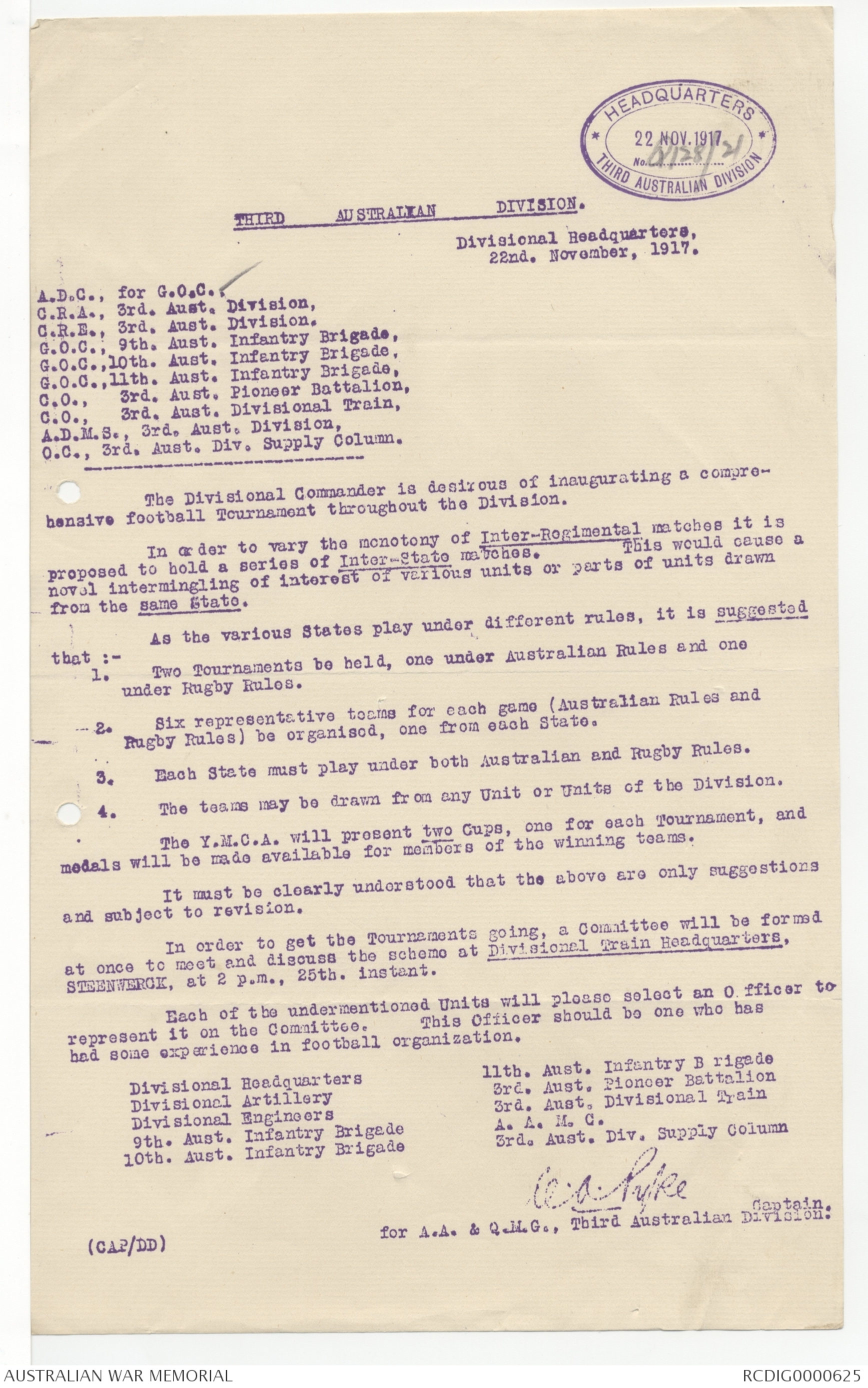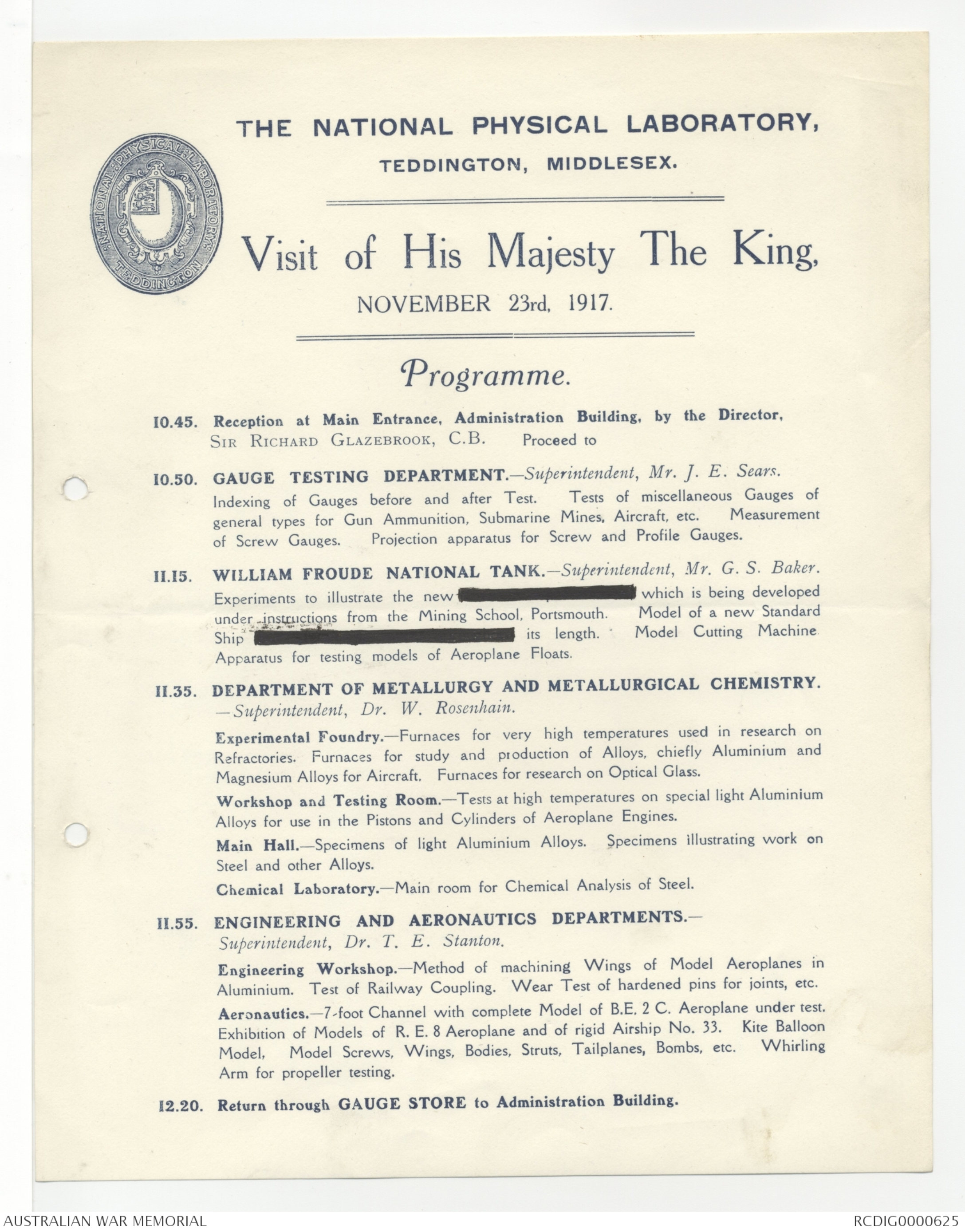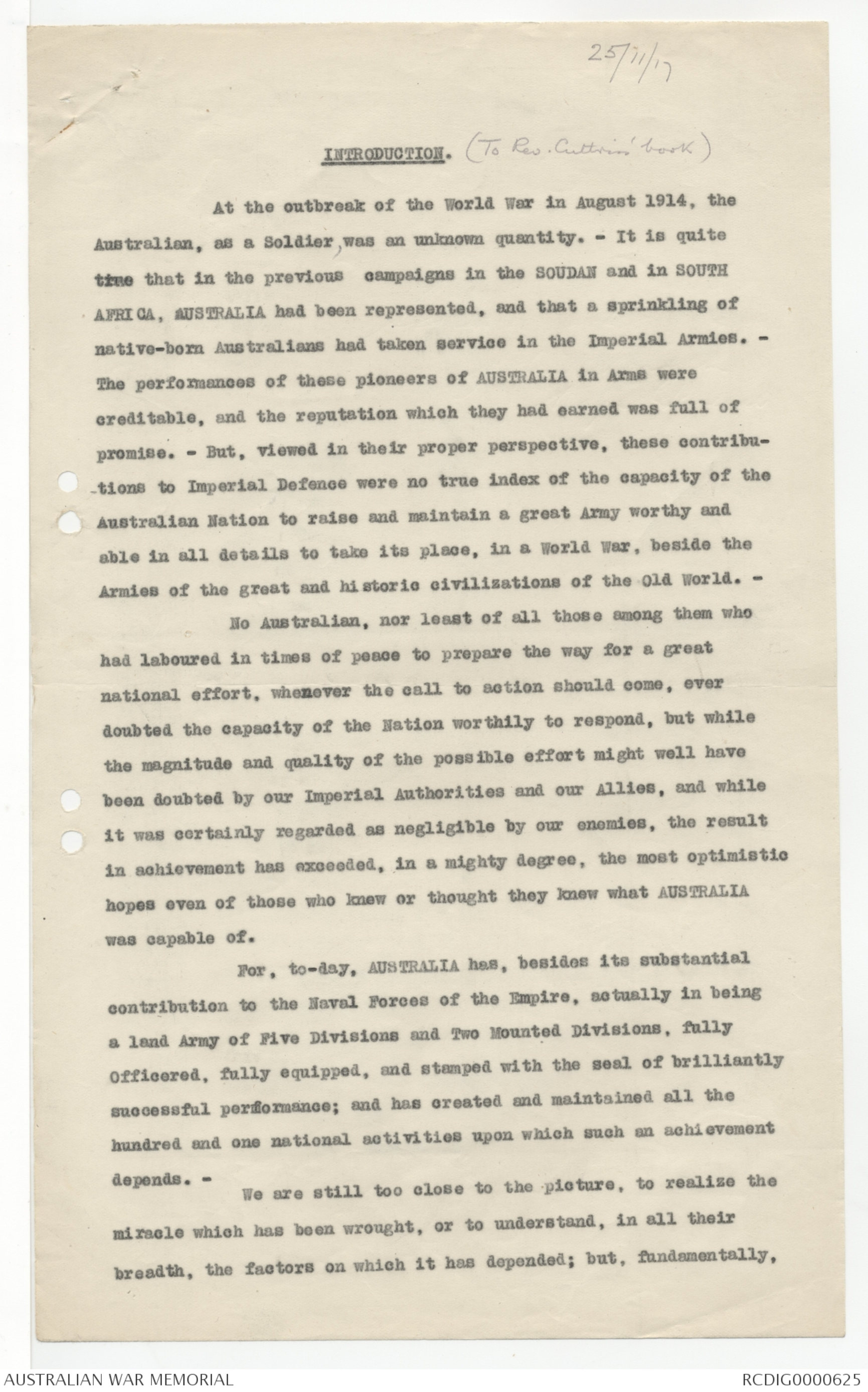General Sir John Monash, Personal Files Book 17, 1 November 1917 - 13 January 1918, Part 7



HEADQUARTERS
22 NOV. 1917
No Q128/21
THIRD AUSTRALIAN DIVISION
THIRD AUSTRALIAN DIVISION
Divisional Headquarters,
22nd. November, 1917.
A.D.C., for G.O.C..√
C.R.A., 3rd. Aust. Division.
C.R.E., 3rd. Aust. Division,
G.O.C., 9th Aust. Infantry Brigade,
G.O.C.,10th. Aust. Infantry Brigade,
G.O.C., 11th. Aust. Infantry Brigade,
C.O., 3rd. Aust. Pioneer Battalion,
C.O., 3rd. Aust. Divisional Train,
A.D.M.S., 3rd. Aust. Division,
C.C., 3rd. Aust. Div. Supply Column.
------------------------
The Divisional Commander is desirous of inaugurating a comprehensive
football Tournament throughout the Division.
In order to vary the monotony of Inter-Regimental matches it is
proposed to hold a series of Inter-State matches. This would cause a
novel intermingling of interest of various units or parts of units drawn
from the same State.
As the various States play under different rules, it is suggested
that :-
1. Two Tournaments be held, one under Australian Rules and one
under Rugby Rules.
2. Six representative teams for each game (Australian Rules and
Rugby Rules) be organised, one from each State.
3. Each State must play under both Australian and Rugby Rules.
4. The teams may be drawn from any Unit or Units of the Division.
The Y.M.C.A. will present two Cups, one for each Tournament, and
medals will be made available for members of the winning teams.
It must be clearly understood that the above are only suggestions
and subject to revision.
In order to get the Tournaments going, a Committee will be formed
at once to meet and discuss the scheme at Divisional Train Headquarters,
STEENWERCK, at 2 p.m., 25th. instant.
Each of the undermentioned Units will please select an 0fficer to
represent it on the Committee. This Officer should be one who has
had some experience in football organization.
Divisional Headquarters 11th. Aust. Infantry Brigade
Divisional Artillery 3rd. Aust. Pioneer Battalion
Divisional Engineers 3rd. Aust. Divisional Train
9th. Aust. Infantry Brigade A. A. M. C.
10th. Aust. Infantry Brigade 3rd. Aust. Div. Supply Column
C. A. Pyke
Captain.
for A.A. & Q.M.G., Third Australian Division.
(CAP/DD)
THE NATIONAL PHYSICAL LABORATORY,
TEDDINGTON, MIDDLESEX.
Visit of His Majesty The King.
NOVEMBER 23rd. 1917.
Programme.
10.45. Reception at Main Entrance, Administration Building, by the Director,
SIR RICHARD GLAZEBROOK, C.B. Proceed to
I0.50. GAUGE TESTING DEPARTMENT. -Superintendent, Mr. J. E. Sears.
Indexing of Gauges before and after Test. Tests of miscellaneous Gauges of
general types for Gun Ammunition, Submarine Mines Aircraft, etc. Measurement
of Screw Gauges. Projection apparatus for Screw and Profile Gauges.
11.15. WILLIAM FROUDE NATIONAL TANK.-Superintendent, Mr. G. S. Baker.
Experiment to illustrate the new xxxxxxxx which is being developed
under instructions from the Mining School. Portsmouth. Model of a new Standard
Ship xxxxxxxxxxxxxxxxxxxx its length. Model Cutting Machine
Apparatus for testing models of Aeroplane Floats.
11.35. DEPARTMENT OF METALLURGY AND METALLURGICAL CHEMISTRY.
Superintendent, Dr. W. Rosenhain.
Experimental Foundry.--Furnaces for very high temperatures used in research on
Refractories. Furnaces for study and production of Alloys, chiefly Aluminium and
Magnesium Alloys for Aircraft. Furnaces for research on Optical Glass.
Workshop and Testing Room. --Tests at high temperatures on special light Aluminium
Alloys for use in the Pistons and Cylinders of Aeroplane Engines.
Main Hall. - Specimens of light Aluminium Alloys. Specimens illustrating work on
Steel and other Alloys.
Chemical Laboratory. -Main room for Chemical Analysis of Steel.
11.55 ENGINEERING AND AERONAUTICS DEPARTMENTS.-
Superintendent, Dr. T. E. Stanton.
Engineering Workshop.-Method of machining Wings of Model Aeroplanes in
Aluminium. Test of Railway Coupling. Wear Test of hardened pins for joints, etc.
Aeronautics. -7-foot Channel with complete Model of B.E.2 C. Aeroplane under test.
Exhibition of Models of R.E. 8 Aeroplane and of rigid Airship No. 33. Kite Balloon
Model, Model Screws, Wings, Bodies, Stuss, Tailplanes, Bombs, etc. Whirling
Arm for propeller testing.
12.20. Return through GAUGE STORE to Administration Building.
25/11/17
INTRODUCTION. (To Rev Cuttriss' book)
At the outbreak of the World War in August 1914, the
Australian, as s Soldier, was an unknown quantity. - It is quite
true that in the previous campaigns in the SOUDAN and in SOUTH
AFRICA, AUSTRALIA had been represented, and that a sprinkling of
native-born Australians had taken service in the Imperial Armies. -
The performances of these pioneers of AUSTRALIA in Arms were
creditable, and the reputation which they had earned was full of
promise. - But, viewed in their proper perspective, these
contributions to Imperial Defence were no true index of the capacity of the
Australian Nation to raise and maintain a great Army worthy and
able in all details to take its place, in a World War, beside the
Armies of the great and historic civilizations of the Old World. -
No Australian, nor least of all those among them who
had laboured in times of peace to prepare the way for a great
national effort, whenever the call to action should come, ever
doubted the capacity of the Nation worthily to respond, but while
the magnitude and quality of the possible effort might well have
been doubted by our Imperial Authorities and our Allies, and while
it was certainly regarded as negligible by our enemies, the result
in achievement has exceeded, in a mighty degree, the most optimistic
hopes even of those who knew or thought they knew what AUSTRALIA
was capable of.
For, to-day, AUSTRALIA has, besides its substantial
contribution to the Naval Forces of the Empire, actually in being
a land Army of Five Divisions and Two Mounted Divisions, fully
Officered, fully equipped, and stamped with the seal of brilliantly
successful performance; and has created and maintained all the
hundred and one national activities upon which such an achievement
depends.-
We are still too close to the picture, to realize the
miracle which has been wrought, or to understand, in all their
breadth, the factors on which it has depended; but, fundamentally,
 Sam scott
Sam scottThis transcription item is now locked to you for editing. To release the lock either Save your changes or Cancel.
This lock will be automatically released after 60 minutes of inactivity.